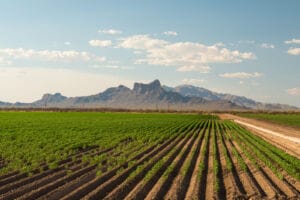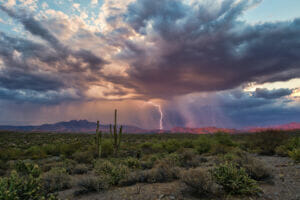As wildfire season approaches, volunteer groups work to remove an invasive plant species that thrives on fire and threatens the native plant population.
Julia Rowe, an invasive-plant specialist at the Arizona Sonora-Desert Museum and leader of the buffel removal program, said buffelgrass and fountain grass are known to be hazardous to the Sonoran Desert because of how flammable and invasive it is. Not only can it take over open patches after wildfires and prevent native plants from growing, but the grass’ flammability creates stronger fires.
“I feel like the people identify with the saguaro cactus and suite of things, if we don’t do anything, then it’s going to turn into a vast grassland, new saguaros won’t come up,” Rowe said. “It affects us in the community.”
Rowe said these invasive plants can be tricky to spot and said she doesn’t recommend people removing buffel or fountain grass on their own without a plant specialist with them.

Many of the volunteer groups that have been working to remove buffel and fountain grass include the buffelgass removal program at the Arizona-Sonora Desert Museum, the Sonoran Weedwackers, the Catalina buffelgrass Slayers and the Glendale Conservation Society in Phoenix.
Rowe said typically the buffel removal group at the Arizona-Sonora Desert Museum starts at 8 a.m. to 10 a.m. before the sun and heat become too overbearing to work. She added that volunteers should be prepared with hiking gear and water since the group commonly hikes through rough terrain.
“One thing I find inspiring is all the other groups who are working hard on this project and put their time into this,” Rowe said.
John Scheuring, a chairman of the Conservation Committee in the Arizona Native Plant Society, said buffelgrass has also been an issue along the Arizona highways.
“I started working with ADOT in 2016 because we have severe cases of buffelgrass on the 1-10 and I-19,” Scheuring said. “I got a lot of support from ADOT leadership, with a lot of work along the highways for buffel grass.”
Scheuring added he leads volunteers in the Coronado National Forest to spray herbicides on buffel and fountain grass, and said he thinks spraying is more effective in removing the plant than pulling them out.
Since the group formed, 81.8 miles and 54 acres have been sprayed by volunteers in places such as the Coronado National Forest, Pima County and “A” mountain in Tucson.
“As we spray over the year there’s less to spray,” Scheuring said. “We’re like gangbusters.”
Scheuring added his group sprays with 18-inch hoses and do spots to prevent killing other plants.
“A lot of city workers spray everything that’s green and in that case you’re not going to get plants that grow back,” Scheuring added.
Marilyn Hanson, 75, one of the founders of the Sonoran Weedwackers, added there’s a lot of physical work involved in removing these invasive plants. She said the group used to carry down the buffelgrass they pulled from the ground in bags to deliver them to landfills, but decided to start putting boulders over the piles of buffelgrass instead.
“It was a lot of work, the bags were 30 pounds a bags,” Hanson said. “We’re all over 60 and there’s no way we want to carry those down the mountain.”
Gregory Brooks, 36, an English teacher at Glendale High School and sponsor of the Glendale Conservation Society, said the club helps to fight these invasive plant species and promote a clean, sustainable, local environment throughout Phoenix and Tucson.
“Primarily, we’ve done basic garbage pickup, we’ve painted over graffiti, removed palm trees and buffelgrass,” Brooks said. “I think it’s really important to remove, it’s a monthly thing.”
The Glendale Conservation Society started in 2016 with 14 students, but Brooks added he sees more students join every year and become more involved in the project. He added that he thinks there’s not enough awareness about the issue in Maricopa County, but hopes to see at least more school districts creating similar conservation clubs like the one at Glendale High School.
“What I would love to see is more school districts involved.” Brooks said. “I can see other educators are discouraged, but I would love to spread that message.”



